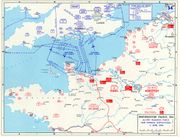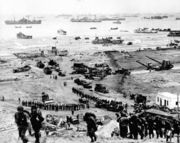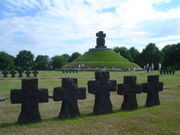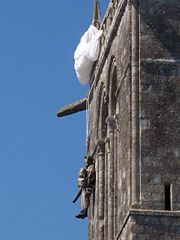Invasion of Normandy
2008/9 Schools Wikipedia Selection. Related subjects: World War II
|
||||||||||||||||||||||||||||||
|
||||||||||||||||||||||||||||||
|
||||||||||||||||||||||||||||||
|
||||||||||||||||||||||||||||||
The Invasion of Normandy was the invasion and establishment of Allied forces in Normandy, France during Operation Overlord in World War II. It covers from the initial landings on June 6, 1944 until the Allied breakout in mid-July.
It was the largest seaborne invasion at the time, involving over 850,000 troops crossing the English Channel from the United Kingdom to Normandy by the end of June 1944.
Allied land forces that saw combat in Normandy on June 6 came from Canada, Free French Forces, the United Kingdom, and the United States. In the weeks following the invasion, Polish forces also participated and there were also contingents from Belgium, Czechoslovakia, Greece, and the Netherlands. Most of the above countries also provided air and naval support, as did the Royal Australian Air Force, Royal New Zealand Air Force and the Royal Norwegian Navy.
The Normandy invasion began with overnight parachute and glider landings, massive air attacks, naval bombardments, an early morning amphibious landing and during the evening the remaining elements of the parachute divisions landed. The "D-Day" forces deployed from bases along the south coast of England, the most important of these being Portsmouth.
Allied preparations
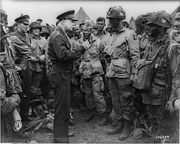
The objective of the operation was to create a lodgement that would be anchored in the city of Caen (and later Cherbourg when its deep-water port would be captured). As long as Normandy could be secured, the Western European campaign and the downfall of Nazi Germany could begin. About 6,900 vessels would be involved in the invasion, under the command of Admiral Sir Bertram Ramsay (who had been directly involved in the North African and Italian landings), including 4,100 landing craft. A total of 12,000 aircraft under Air Marshal Sir Trafford Leigh-Mallory were to support the landings, including 1,000 transports to fly in the parachute troops; 10,000 tons of bombs would be dropped against the German defenses, and 14,000 attack sorties would be flown.
Some of the more unusual Allied preparations included armoured vehicles specially adapted for the assault. Developed under the leadership of Maj. Gen. Percy Hobart (Montgomery’s brother-in-law, and an armoured warfare specialist), these vehicles (nicknamed Hobart's Funnies) included "swimming" Duplex Drive Sherman tanks, the Churchill Crocodile flame throwing tank, mine-clearing tanks, bridge-laying tanks and road-laying tanks and the Armoured Vehicle, Royal Engineers ( AVRE)–equipped with a large-caliber mortar for destroying concrete emplacements. Some prior testing of these vehicles had been undertaken at Kirkham Priory in Yorkshire, England. The majority would be operated by small teams from the British 79th Armoured Division attached to the various formations.
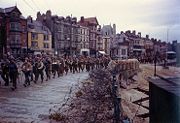
Planning of the Invasion
Allied forces rehearsed their roles for D-Day months before the invasion. On April 28, 1944, in south Devon on the English coast, 638 U.S. soldiers and sailors were killed when German torpedo boats surprised one of these landing exercises, Exercise Tiger.
In the months leading up to the invasion, the Allies conducted a deception operation, Operation Fortitude aimed at misleading the Germans regarding the date and place of the invasion.
There were several leaks prior to or on D-Day. One such leak was the crossword that came out in The Herald and Review six days before the beach landings were to take place. Some of the answers consisted of Overlord, Neptune, Gold and other key terms to the invasions; the US government later declared that this was just a coincidence. Through the Cicero affair, the Germans obtained documents containing references to Overlord, but these documents lacked all detail. Double Cross agents, such as Juan Pujol (code named Garbo), played an important role in convincing the German High Command that Normandy was at best a diversionary attack. Another such leak was Gen. Charles de Gaulle's radio message after D-Day. He, unlike all the other leaders, stated that this invasion was the real invasion. This had the potential to ruin the Allied deceptions Fortitude North and Fortitude South. For example, Gen. Eisenhower referred to the landings as the initial invasion.
Codenames
The Allies assigned codenames to the various operations involved in the invasion. Overlord was the name assigned to the establishment of a large-scale lodgement on the Continent. The first phase, the establishment of a secure foothold, was codenamed Neptune. According to the D-day museum:
- "The armed forces use codenames to refer to the planning and execution of specific military operations. Operation Overlord was the codename for the Allied invasion of northwest Europe. The assault phase of Operation Overlord was known as Operation Neptune. (...) Operation Neptune began on D-Day ( 6 June 1944) and ended on 30 June 1944. By this time, the Allies had established a firm foothold in Normandy. Operation Overlord also began on D-Day, and continued until Allied forces crossed the River Seine on 19 August 1944."
Allied Order of Battle
D-Day
The following major units were landed on D-Day. A much more detailed order of battle for D-Day itself can be found at Normandy landings.
- British 6th Airborne Division.
- British I Corps, British 3rd Infantry Division and the British 27th Armoured Brigade.
- Canadian 3rd Infantry Division, Canadian 2nd Armoured Brigade
- British XXX Corps, British 50th Infantry Division and British 8th Armoured Brigade.
- 79th Armoured Division
- U.S. V Corps, U.S. 1st Infantry Division and U.S. 29th Infantry Division.
- U.S. VII Corps, U.S. 4th Infantry Division.
- U.S. 101st Airborne Division.
- U.S. 82nd Airborne Division.
The total number of troops landed on D-Day was around 130,000-156,000
Subsequent days
The total troops, vehicles and supplies landed over the period of the invasion were:
- By the end of 11 June (D + 5), 326,547 troops, 54,186 vehicles and 104,428 tons of supplies.
- By June 30th (D+24) over 850,000 men, 148,000 vehicles, and 570,000 tons of supplies.
- By July 4th one million men had been landed.
Naval participants

The Invasion Fleet was drawn from 8 different navies, comprising 6,939 vessels: 1,213 warships, 4,126 transport vessels (landing ships and landing craft), and 736 ancillary craft and 864 merchant vessels.
The overall commander of the Allied Naval Expeditionary Force, providing close protection and bombardment at the beaches, was Admiral Sir Bertram Ramsay. The Allied Naval Expeditionary Force was divided into two Naval Task Forces: Western (Rear-Admiral Alan G Kirk) and Eastern (Rear-Admiral Sir Philip Vian).
The warships provided cover for the transports against the enemy—whether in the form of surface warships, submarines, or as an aerial attack—and gave support to the landings through shore bombardment. These ships included the Allied Task Force "O".
German Order of Battle
The number of military forces at the disposal of Nazi Germany reached its peak during 1944. Tanks on the east front peaked at 5,202 in November 1944, while total aircraft in the Luftwaffe inventory peaked at 5,041 in December 1944. By D-Day 157 German divisions were stationed in the Soviet Union, 6 in Finland, 12 in Norway, 6 in Denmark, 9 in Germany, 21 in the Balkans, 26 in Italy and 59 in France, Belgium and the Netherlands. However, these statistics are somewhat misleading since a significant number of the divisions in the east were depleted; German records indicate that the average personnel complement was at about 50% in the spring of 1944.
A more detailed order of battle for D-Day itself can be found at Normandy landings.
Atlantic Wall
Standing in the way of the Allies was the English Channel, a crossing which had eluded the Spanish Armada and Napoleon Bonaparte's Navy. Compounding the invasion efforts was the extensive Atlantic Wall, ordered by Hitler in his Directive 51. Believing that any forthcoming landings would be timed for high tide (this caused the landings to be timed for low tide), Rommel had the entire wall fortified with tank top turrets and extensive barbed wire, and laid a million mines to deter landing craft. The sector which was attacked was guarded by four divisions.
Divisional Areas
The following units were deployed in a static defensive mode in the areas of the actual landings:
- 716th Infantry Division (Static) consisted mainly of those 'unfit for active duty' and released prisoners.
- 352nd Infantry Division, a well-trained unit containing combat veterans.
- 91st Air Landing Division (Luftlande – air transported), a regular infantry division, trained, and equipped to be transported by air.
- 709th Infantry Division (Static). Like the 716th, this division comprised a number of "Ost" units who were provided with German leadership to manage them.
Adjacent Divisional Areas
Other divisions occupied the areas around the landing zones, including:
- 243rd Infantry Division (Static) (Generalleutnant Heinz Hellmich), comprising the 920th Infantry Regiment (two battalions), 921st Infantry Regiment, and 922nd Infantry Regiment. This coastal defense division protected the western coast of the Cotentin Peninsula.
- 711th Infantry Division (Static), comprising the 731th Infantry Regiment, and 744th Infantry Regiment. This division defended the western part of the Pays de Caux.
- 30th Mobile Brigade (Oberstleutnant Freiherr von und zu Aufsess), comprising three bicycle battalions.
Armoured reserves
Rommel's defensive measures were also frustrated by a dispute over armoured doctrine. In addition to his two army groups, von Rundstedt also commanded the headquarters of Panzer Group West under General Leo Geyr von Schweppenburg (usually referred to as von Geyr). This formation was nominally an administrative HQ for von Rundstedt's armoured and mobile formations, but it was later to be renamed Fifth Panzer Army and brought into the line in Normandy. Von Geyr and Rommel disagreed over the deployment and use of the vital Panzer divisions.
Rommel recognised that the Allies would possess air superiority and would be able to harass his movements from the air. He therefore proposed that the armoured formations be deployed close to the invasion beaches. In his words, it was better to have one Panzer division facing the invaders on the first day, than three Panzer divisions three days later when the Allies would already have established a firm beachhead. Von Geyr argued for the standard doctrine that the Panzer formations should be concentrated in a central position around Paris and Rouen, and deployed en masse against the main Allied beachhead when this had been identified.
The argument was eventually brought before Hitler for arbitration. He characteristically imposed an unworkable compromise solution. Only three Panzer divisions were given to Rommel, too few to cover all the threatened sectors. The remainder, nominally under Von Geyr's control, were actually designated as being in " OKW Reserve". Only three of these were deployed close enough to intervene immediately against any invasion of Northern France, the other four were dispersed in southern France and the Netherlands. Hitler reserved to himself the authority to move the divisions in OKW Reserve, or commit them to action. On June 6, many Panzer division commanders were unable to move because Hitler had not given the necessary authorisation, and his staff refused to wake him upon news of the invasion.
Army Group B Reserve
- The 21st Panzer Division (Generalmajor Edgar Feuchtinger) was deployed near Caen as a mobile striking force as part of the Army Group B reserve. However, Rommel placed it so close to the coastal defenses that, under standing orders in case of invasion, several of its infantry and anti-aircraft units would come under the orders of the fortress divisions on the coast, reducing the effective strength of the division.
The other two armoured divisions over which Rommel had operational control, the 2nd Panzer Division and 116th Panzer Division, were deployed near the Pas de Calais in accordance with German views about the likely Allied landing sites. Neither was moved from the Pas de Calais for at least fourteen days after the invasion.
OKW Reserve
The other mechanized divisions capable of intervening in Normandy were retained under the direct control of the German Armed Forces HQ ( OKW) and were initially denied to Rommel:
Four divisions were deployed to Normandy within seven days of the invasion:
- The 12th SS Panzer Division Hitlerjugend (Brigadeführer Fritz Witt) was stationed to the southeast. Its officers and NCOs (this division had a very weak core of NCOs in Normandy with only slightly more than 50% of its authorised strength) were long-serving veterans, but the junior soldiers had all been recruited directly from the Hitler Youth movement at the age of seventeen in 1943. It was to acquire a reputation for ferocity and war crimes in the coming battle.
- Further to the southwest was the Panzerlehrdivision (General major Fritz Bayerlein), an elite unit originally formed by amalgamating the instructing staff at various training establishments. Not only were its personnel of high quality, but the division also had unusually high numbers of the latest and most capable armoured vehicles.
- 1st SS Panzer Division Leibstandarte SS Adolf Hitler was refitting in Belgium on the Netherlands border after being decimated on the Eastern Front.
- 17th SS Panzergrenadier Division Götz von Berlichingen (General major Werner Ostendorff) was based on Thouars, south of the Loire River, and although equipped with Assault guns instead of tanks and lacking in other transport (such that one battalion each from the 37th and 38th Panzergrenadier Regiments moved by bicycle), it provided the first major counterattack against the American advance at Carentan on June 13.
Three other divisions (the 2nd SS Division Das Reich, which had been refitting at Montauban in Southern France, and the 9th SS Panzer Division Hohenstaufen and 10th SS Panzer Division Frundsberg which had been in transit from the Eastern Front on June 6), were committed to battle in Normandy around twenty-one days after the first landings.
One more armoured division (the 9th Panzer Division) saw action only after the American breakout from the beachhead. Two other armoured divisions which had been in the west on June 6 (the 11th Panzer Division and 19th Panzer Division) did not see action in Normandy.
Landings
Allied establishment in France
The Allied invasion plans had called for the capture of Saint-Lô, Caen, and Bayeux on the first day, with all the beaches linked except Utah, and Sword (the last linked with paratroopers) and a front line 10 to 16 kilometres (6–10 mi) from the beaches. However practically none of these objectives had been achieved. Overall the casualties had not been as heavy as some had feared (around 10,000 compared to the 20,000 Churchill had estimated) and the bridgeheads had withstood the expected counterattacks.
Once the beachhead was established, two artificial Mulberry harbours were towed across the English Channel in segments and made operational around D+3 ( June 9). One was constructed at Arromanches by British forces, the other at Omaha Beach by American forces. By June 19, when severe storms interrupted the landing of supplies for several days and destroyed the Omaha harbour, the British had landed 314,547 men, 54,000 vehicles, and 102,000 tons of supplies, while the Americans put ashore 314,504 men, 41,000 vehicles, and 116,000 tons of supplies. Around 9,000 tons of materiel were landed daily at the Arromanches harbour until the end of August 1944, by which time the port of Cherbourg had been secured by the Allies and had begun to return to service.
Assessment of the battle
The Normandy landings were the first successful opposed landings across the English Channel in nine centuries. They were costly in terms of men, but the defeat inflicted on the Germans was one of the largest of the war. Strategically, the campaign led to the loss of the German position in most of France and the secure establishment of a new major front. Allied material weight told heavily in Normandy, as did intelligence and deception plans. The general Allied concept of the battle was sound, drawing on the strengths of both Britain and the United States. German dispositions and leadership were often faulty, despite a credible showing on the ground by many German units. In larger context the Normandy landings helped the Soviets on the Eastern front, who were facing the bulk of the German forces and, to a certain extent, contributed to the shortening of the conflict there.
Although there was a shortage of artillery ammunition, at no time were the Allies critically short of any necessity. This was a remarkable achievement considering they did not hold a port until Cherbourg fell. By the time of the breakout the Allies also enjoyed a considerable superiority in numbers of troops (approximately 7:2) and armoured vehicles (approximately 4:1) which helped overcome the natural advantages the terrain gave to the German defenders.
Allied intelligence and counterintelligence efforts were successful beyond expectations. The Operation Fortitude deception before the invasion kept German attention focused on the Pas de Calais, and indeed high-quality German forces were kept in this area, away from Normandy, until July. Prior to the invasion, few German reconnaissance flights took place over Britain, and those that did saw only the dummy staging areas. Ultra decrypts of German communications had been helpful as well, exposing German dispositions and revealing their plans such as the Mortain counterattack.
Allied air operations also contributed significantly to the invasion, via close tactical support, interdiction of German lines of communication (preventing timely movement of supplies and reinforcements—particularly the critical Panzer units), and rendering the Luftwaffe ineffective in Normandy. Although the impact upon armoured vehicles was less than expected, air activity intimidated these units and cut their supplies.
Despite initial heavy losses in the assault phase, Allied morale remained high. Casualty rates among all the armies were tremendous, and the Commonwealth forces had to create a new category—Double Intense—to be able to describe them.
German leadership
German commanders at all levels failed to react to the assault phase in a timely manner. Communications problems exacerbated the difficulties caused by Allied air and naval firepower. Local commanders also seemed unequal to the task of fighting an aggressive defense on the beach, as Rommel envisioned. For example, the commander of the German 352nd Infantry Division failed to capitalise on American difficulty at Omaha, committing his reserves elsewhere when they might have been more profitably used against the American beachhead.
The German High Command remained fixated on the Calais area, and von Rundstedt was not permitted to commit the armoured reserve. When it was finally released late in the day, any chance of success was much more difficult. Overall, despite considerable Allied material superiority, the Germans kept the Allies bottled up in a small beachhead for nearly two months, aided immeasurably by terrain factors.
Although there were several well-known disputes among the Allied commanders, their tactics and strategy were essentially determined by agreement between the main commanders. By contrast, the German leaders were bullied and their decisions interfered with by Hitler, controlling the battle from a distance with little knowledge of local conditions. Field Marshals von Rundstedt and Rommel repeatedly asked Hitler for more discretion but were refused. Von Rundstedt was removed from his command on June 29 after he bluntly told the Chief of Staff at Hitler's Armed Forces HQ (Field Marshal Keitel) to "Make peace, you idiots!" Rommel was severely injured by Allied aircraft on July 16.
The German commanders also suffered in the quality of the available troops. Sixty thousand of the 850,000 in Rundstedt's command were raised from the many prisoners of war captured on the Eastern Front. These "Ost" units had volunteered to fight against Stalin, but when instead unwisely used to defend France against the Western Allies, ended up being unreliable. Many surrendered or deserted at the first available opportunity.
Given the Soviets' later domination of Eastern Europe, if the Normandy invasion had not occurred there might conceivably have been a complete occupation of northern and western Europe by communist forces, a contention which is supported by Stalin's statement that the Allies introduced their social system as far as their armies could reach. This is an opinion heavily disputed by the fact that Stalin requested a prompt Western invasion several times during the Teheran Conference and accused Churchill of not supporting the operation.
Alternately, Hitler might have deployed more forces to the Eastern Front, conceivably delaying Soviet advance beyond their pre-war border. In practice though, German troops remained in the West even in the absence of an invasion.
War memorials and tourism
The beaches at Normandy are still referred to on maps and signposts by their invasion codenames. There are several vast cemeteries in the area. The American cemetery, in Colleville-sur-Mer, contains row upon row of identical white crosses and Stars of David, immaculately kept, commemorating the American dead. Commonwealth graves, in many locations, use white headstones engraved with the person's religious symbol and their unit insignia. The largest cemetery in Normandy is the La Cambe German war cemetery, which features granite stones almost flush with the ground and groups of low-set crosses. There is also a Polish cemetery.
Streets near the beaches are still named after the units that fought there, and occasional markers commemorate notable incidents. At significant points, such as Pointe du Hoc and Pegasus Bridge, there are plaques, memorials or small museums. The Mulberry harbour still sits in the sea at Arromanches. In Sainte-Mère-Église, a dummy paratrooper hangs from the church spire. On Juno Beach, the Canadian government has built the Juno Beach Information Centre, commemorating one of the most significant events in Canadian military history.
In England the most significant memorial is the D-Day Museum in Southsea, Hampshire. The Museum was opened in 1984 to commemorate the 40th Anniversary of D-Day. Its centrepiece is the magnificent Overlord Embroidery commissioned by Lord Dulverton of Batsford (1915-92) as a tribute to the sacrifice and heroism of those men and women who took part in Operation Overlord.
June 5, 1994 a drumhead service was held on Southsea Common adjacent the D-Day Museum. This service was attended by US President Bill Clinton, HM Queen Elizabeth II and over 100,000 members of the public.
Dramatizations
The battle of Normandy has been the topic of many films, television shows, songs, computer games and books. Many dramatizations focus on the initial landings, and these are covered at Normandy Landings. Some examples that cover the wider battle include:
- Films
- Saving Private Ryan, a 1998 Academy Award-winning American film directed by Steven Spielberg and starring Tom Hanks and Matt Damon.
- Band of Brothers, a 2001 American miniseries produced by Steven Spielberg and Tom Hanks based on the book of the same name by Stephen Ambrose.
- Video games
- Brothers in Arms series
- Call of Duty series
- Close Combat series
- Company of Heroes
- Day of Defeat
- Medal of Honour series
- Wargames
- Atlantic Wall, a large 1970s American board wargame by SPI depicting the battle from the landings through to the breakout, at company and battalion level, and using a similar game system to Wacht Am Rhein. Due to be reprinted in 2008.
- "Breakout: Normandy", an American board wargame published by Avalon Hill in 1992 covers the full invasion, starting with D-day and covering the week following.
- "Memoir 44", an American and French two player game that was released for the 60th anniversary of the D-Day landings. With available expansions, you can go from the Landings at D-Day, to the Eastern Front, to the beaches of Japanese held islands.

